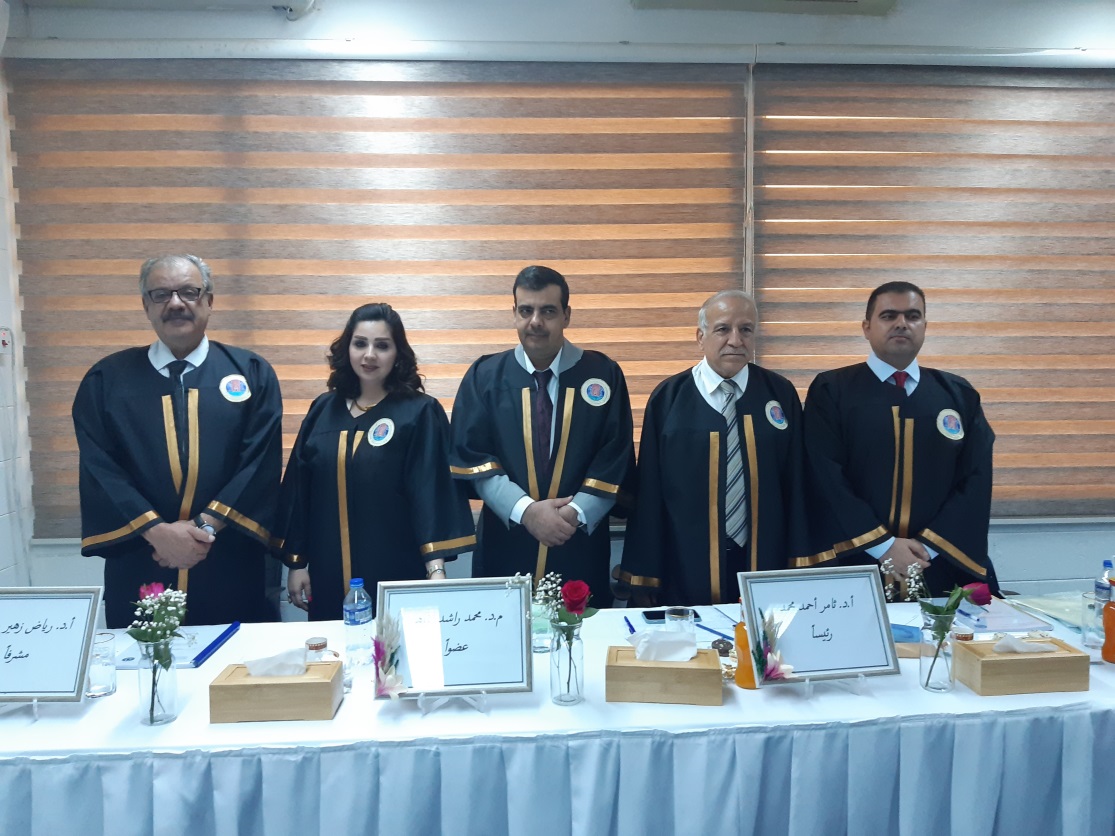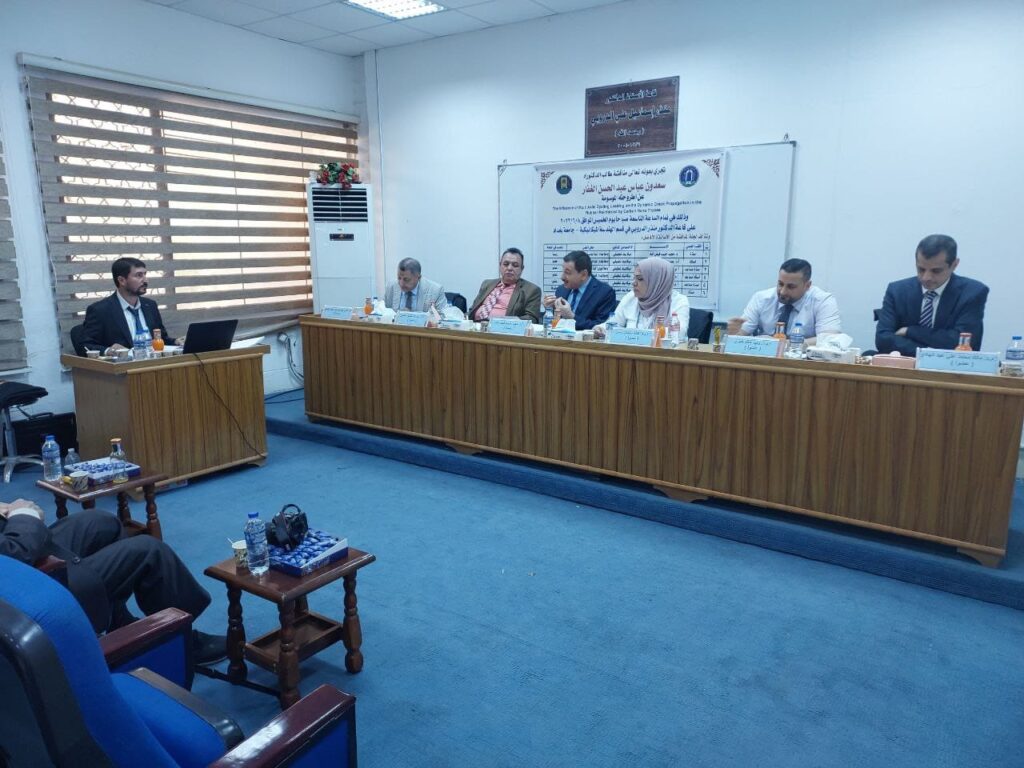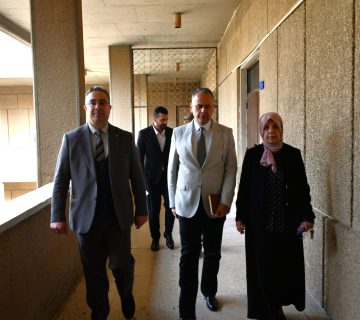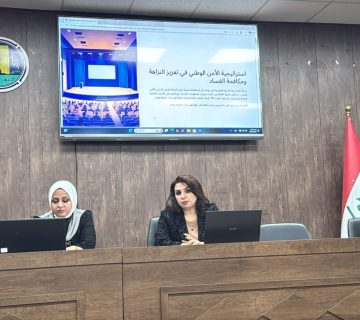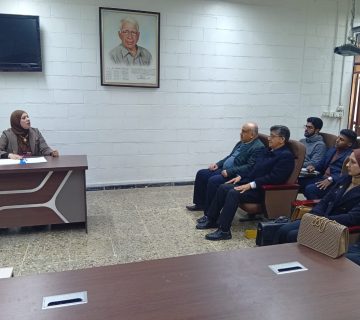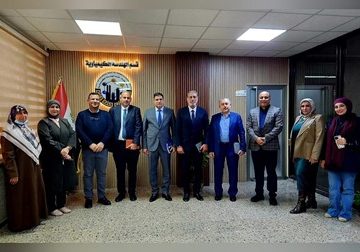It was conducted on Thursday, 8/6/2023, in hall of Dr. Munther Al-Droubi the discussion of the doctoral dissertation of the student Sadoon Abbas Abdulhasan, which is tagged:
“The Influence of Multi Axial Cyclic Loading on the Velocity of Crack Propagation in the Rubber Reinforced with Carbon Black”.
The discussion committee consisted of names listed below:
Prof. Dr. Majid Habeeb Faidh-Allah – University of Baghdad / College of Engineering / Department of Mechanical Engineering – Chairman.
Prof. Dr. Abdullah Dhayea Assi – University of Baghdad / College of Engineering / Department of Mechanical Engineering – Member.
Asst.Prof. Dr. Hala Salman Hasan – University of Nahrain / College of Engineering / Department of Mechanical Engineering – Member.
Asst. Prof. Dr. Waleed Al-Ashtari – University of Baghdad/ College of Engineering/ Department of Mechanical Engineering– Member.
Asst. Prof. Dr. Malik M.Ali Al-Isawi – University of Baghdad/ Al-Khawarizmi College of Engineering / Department of Mechatronics Engineering – Member.
Prof. Dr. Fathi Abdulsahib Al-Shamma’a – University of Baghdad/ College of Engineering/ Department of Mechanical Engineering– Supervisor.
The dissertation was summarized as follows:
The motivation behind this study is the influence of multi axial cycling loading on the velocity of crack propagation in the rubber reinforced with carbon black. The compounds are vul-canized by three different curing systems, namely conventional vulcanization, semi-efficient vulcanization, and efficient vulcanization. These dampers must have Suitable resistance to crack growth the appropriate dissipative behavior and simultaneously good mechanical properties. For this purpose, styrene-butadiene rubber / natural rubber blend reinforced with hybrid fillers was synthesized. The related instruments analyzed the including curing properties, swelling behavior, morphological and mechanical characteristics, and viscoelastic behavior. Results of the rheometric test showed that the addition of natural rubber and using the conventional vulcanization system reduced the scorch and optimum cure time and increased the crosslink density. The improvement of dynamic-mechanical properties was confirmed by tensile, tear, and Dynamic mechanical thermal analysis tests. The crack growth behavior and dissipative behavior as was evaluated by viscoelastic tests, hysteresis, and a multi-axial testing system.
This work is divided into two parts theoretical and experimental. The first is the experimental part. Its main objective consists of two branches; the first is to determine the mechanical properties of the twelve stocks or dough such as the tensile test, tear and the hardness test. And find the best or best represented stocks in the second branch of the experimental test. The second branch involves the influence of multiaxial cycling loading on the speed of crack propagation on the optimal or better stock which is represented in the first branch. While in the theoretical analysis, for the first time an equation is found for the effect of multi-axis loading on the speed of crack propagation in rubber using the energy equation for the equivalent pressure of disproportionate loading, taking into account the effect of the dynamic elastic modulus, which depends on the viscous rubber behavior over time, and then it is solved by substituting in Dynamic crack propagation equation, the equation was solved using programming in MATLAB, and then these results were compared with the experimental results. The results showed that the composite based on styrene-butadiene rubber/natural rubber mixture at a ratio of 12/20 of Nano carbon 550/330 and Nano Silica 48 and treated with the traditional vulcanization system achieved the best results in terms of mechanical dissipation properties.
In the analysis of the present problem, Abaqus 2017 software, which is based on the finite element method, was used to verify the results. For this purpose, the problem of analyzing the crack growth of the sample under multi-axial cyclic load was fully modeled according to the experimental test in Abaqus, and finally, the finite element method results, including the crack growth rate in different number of cycles It was received. Comparing the results between finite element method and MATLAB program, as well as comparing it with experimental results, shows the accuracy of the results, so that the average error percentage is equal to 22.58% and 26.05%, respectively. and through results In comparing natural rubber with rubber reinforced by carbon black, we found that the crack length decreased by 60% with the number of cycles and the crack growth rate decreased by more than 48% as a result of the effect of dynamic elastic properties over time. it was observed that the relationship of da/dn with the N cycle would be affected by 56% which affects the value of c and m found in the Paris equation.
After scientific discussions by the discussion committee members on the contents of the dissertation in-depth and expressing their observations, directives, and defense by the student, the dissertation was accepted and the student was awarded the Ph.D. in mechanical engineering sciences with a grade of excellent.
On this occasion, we cannot help but extend our thanks to the student Sadoon Abbas Abdulhasan, for his outstanding efforts throughout the study period, wishing him continued success. We also thank the supervisor and the discussion committee members, for their tireless and distinguished effort, in a way that befits the submission of the dissertation in the best way and in accordance with the scientific level presented.

